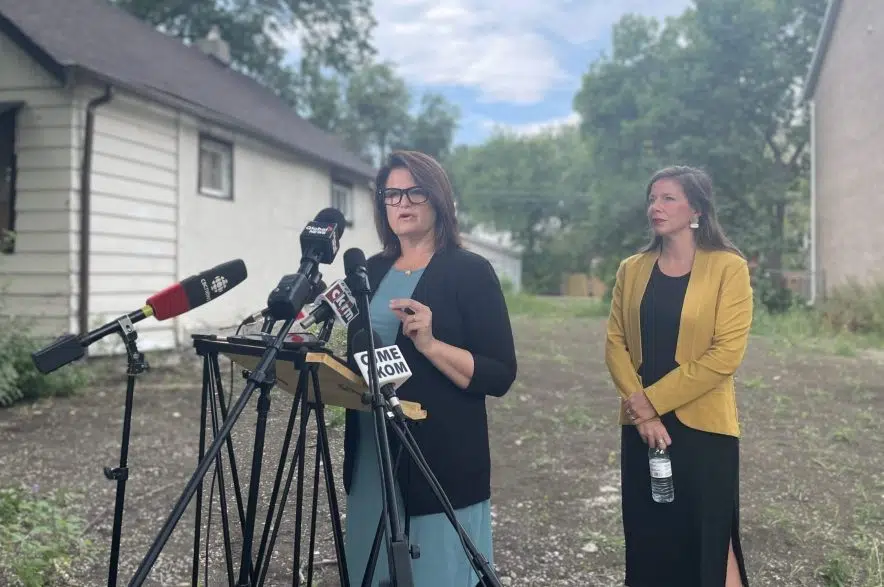Standing in front of a vacant, boarded-up unit in Regina, NDP Leader Carla Beck said the Saskatchewan Housing Corporation vacancy rate had shot up 474 per cent in Regina.
“It’s a government that looks like they don’t want to do their day job,” Beck said Tuesday in reference to the Saskatchewan Party. “They don’t want to do the hard work of actually governing, and finding solutions to these problems.”
According to documents from the corporation shared by the NDP, 3,161 vacant units sat empty across the province last year. In Regina, 691 of 2,986 units sat empty, making for roughly one in four empty SHC units. The information was uncovered through a Freedom of Information submission.
MLA Meara Conway said the vacant units are in relation to a spike in homelessness.
“It’s very stark, this combination of the vacant units, nearly 700 of them, (and) the number of people on that waitlist that have been waiting over a year for that unit,” said Conway. “Then just the visual of what’s happening at City Hall, it’s such a failure on the part of the Sask. Party government.”
A tent city protesting homelessness in Regina sprang up in the courtyard in front of Regina City Hall in June.
The NDP said when it received the vacancy rates, it was difficult to get people to speak publicly because they were on the housing waitlist, and were concerned about being blacklisted by the provincial government. Conway heard the struggles from seniors, single moms, people with disabilities, and people in need of supportive housing.
Conway questioned what the plan will be for shelters as the months grow colder.
“I think the Sask. Party government does not care about certain swathes of the population,” she said. “I think we are seeing that with the SIS program.
“Everyone under the sun has told them that this is an epic failure of a program and they have dug their heels in and refused to adjust it.”
Beck said the provincial government needs to do better work to bring in more people to work with other municipalities and create stronger strategies for supportive living.
The report shows a drastic increase of 1,084 per cent in the vacancy rate for senior housing in the last decade.
Conway explained asset cliffs set in place are not flexible enough for people who make just over the limit.
High vacancy rates were also an issue in other regions of the province.
That includes:
- Estevan with 110 of 295 units sitting vacant (37 per cent)
- Meadow Lake with 62 of 213 units sitting vacant (29 per cent)
- The Battlefords with 143 of 629 units sitting vacant (23 per cent)
- Prince Albert with 159 of 934 units sitting vacant (17 per cent)
Makowsky responds
Gene Makowsky, the provincial minister of social services, hit back at the NDP and explained the provincial government invests a lot of money into the units.
“I might disagree that we have let them become dilapidated. Some that are chronically underused, we haven’t put assets into them,” said Makowsky.
He noted each year, the government invests $75 million into fixing units. Supply chain issues and lack of contractors have caused longer wait times to fix the units.
Makowsky said the vacancy rates have lowered since last year.
“I’d say that we spend a lot of money keeping and upgrading our units. Some of the them are used and unfortunately destroyed by some tenants,” said Makowsky.
Most of the units are for people who can live independently without the requirement for extra services. Makowsky said the government is bringing in more wraparound services for people with addictions issues and people with disabilities.
According to Makowsky, extra efforts have been put in place to make the units more accessible. The government has lowered the age for seniors units to 55, lowered asset limits particularly in rural Saskatchewan, and is currently expanding a pilot project for people to live with roommates while still qualifying for social assistance. Income assistance amounts have remained steady for clients for the past few years.
Despite that, Makowsky said vacancies over the past 10 years have risen from people who turned to the private sector.
“I will point out that some of our units are older. Many were built in the ’70s so they may not have the same amenities as some of the private sector ones that were built five years ago,” he said.
In an emailed statement, the Ministry of Social Services confirmed asset thresholds for the social housing program are $300,000 for seniors over 55, and $50,000 for families.
The income cap for the province is determined by the amount of people living in one space, or if a tenant has a disability. For a single person with no dependents and no disabilities, the income cap will sit at $40,500.
The cap for a person with four dependents and a disability is set at $89,100. There isn’t an asset limit for those who require a fully accessible apartment.
The ministry confirmed 1,505 units are currently available for rent across the province; that’s broken down into 360 family units and 1,145 senior units. The units that remain are under repair, require repair or are not yet rent ready.
Makowsky said he himself has not visited the tent encampment in front of City Hall due to safety concerns, but does have social service workers offering support to the homeless.











